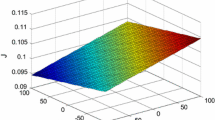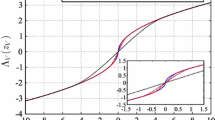Abstract
A nonlinear adaptive controller design method for output tracking of hypersonic flight vehicles (HFVs) subject to input nonlinearity is proposed in this paper. The parameters of the input nonlinearity are assumed to be unknown. This problem is challenging because of the complex nonlinearity of HFVs and the existence of the unknown input nonlinearity. The nonlinear model of HFVs is linearized, and the internal dynamics of this model are constructed. Since the internal dynamics of HFVs are non-minimum, an ideal internal dynamics (IID)-based control strategy is utilized and a states tracking model is constructed based on the computed IID. Then a nonlinear adaptive control strategy is designed to guarantee the bounded of output tracking error in the existence of unknown input nonlinearity. Comparison simulation results are provided to verify the available of the proposed method.











Similar content being viewed by others
Abbreviations
- \(C_{D}\left( \alpha ,\delta _{e}\right) \) :
-
Drag coefficient
- \(C_{D}^{\alpha _{i}}\) :
-
ith-order coefficient of \(\alpha \)contribution to \(C_{D}\left( \alpha ,\delta _{e}\right) \)
- \(C_{D}^{\delta _{e}^{i}}\) :
-
ith-order coefficient of \(\delta _{e}\) contribution to \(C_{D}\left( \alpha ,\delta _{e}\right) \)
- \(C_{D}^{0}\) :
-
Constant term in \(C_{D}\left( \alpha ,\delta _{e}\right) \)
- \(C_{L}\left( \alpha ,\delta _{e}\right) \) :
-
Lift coefficient
- \(C_{L}^{\alpha _{i}}\) :
-
ith-order coefficient of \(\alpha \) contribution to \(C_{L}\left( \alpha ,\delta _{e}\right) \)
- \(C_{L}^{\delta _{e}}\) :
-
Coefficient of \(\delta _{e}\) contribution to \(C_{L}\left( \alpha ,\delta _{e}\right) \)
- \(C_{L}^{0}\) :
-
Constant term in \(C_{L}\left( \alpha ,\delta _{e}\right) \)
- \(C_{M,\alpha }\left( \alpha \right) \) :
-
Contribution to moment due to angle of attack
- \(C_{M,\delta _{e}}\left( \delta _{e},\delta _{c}\right) \) :
-
Control surface contribution to moment
- \(C_{M,\alpha }^{\alpha _{i}}\) :
-
ith-order coefficient of \(\alpha \) contribution to \(C_{M,\alpha }\left( \alpha \right) \)
- \(C_{M,\alpha }^{0}\) :
-
Constant term in \(C_{M,\alpha }\left( \alpha \right) \)
- \(C_{T}^{\alpha _{i}}\left( \Phi \right) \) :
-
ith-order coefficient of \(\alpha \) in T
- \(\bar{c}\) :
-
Mean aerodynamic chord
- \(c_{c}\) :
-
Canard coefficient in \(C_{M,\delta _{e}}\left( \delta _{e},\delta _{c}\right) \)
- \(c_{e}\) :
-
Elevator coefficient in \(C_{M,\delta _{e}}\left( \delta _{e},\delta _{c}\right) \)
- D :
-
Drag
- g :
-
Acceleration due to gravity
- h :
-
Altitude
- \(I_{yy}\) :
-
Moment of inertia
- L :
-
Left
- \(L_{v}\) :
-
Vehicle length
- M :
-
Pitching moment
- m :
-
Vehicle mass
- \(N_{i}\) :
-
ith generalized force
- \(N_{i}^{\alpha _{j}}\) :
-
jth-order contribution of \(\alpha \) to \(N_{i}\)
- \(N_{i}^{0}\) :
-
Constant term in \(N_{i}\)
- \(N_{2}^{\delta _{e}}\) :
-
Contribution of \(\delta _{e}\) to \(N_{2} \)
- Q :
-
Pitch rate
- \(\bar{q}\) :
-
Dynamic pressure
- S :
-
Reference area
- T :
-
Trust
- V :
-
Velocity
- x :
-
State of the control-oriented model
- \(\alpha \) :
-
Angle of attack
- \(\beta _{i}\left( h,\bar{q}\right) \) :
-
ith thrust fit parameter
- \(\gamma \) :
-
Flight path angle, \(\gamma =\theta -\alpha \)
- \(\delta _{c}\) :
-
Canard angular deflection
- \(\delta _{e}\) :
-
Elevator angular deflection
- \(\xi \) :
-
Damping ratio for the \(\Phi \) dynamics
- \(\xi _{i}\) :
-
Damping ratio for elastic mode \(\eta _{i}\)
- \(\eta _{i}\) :
-
ith generalized elastic coordinate
- \(\theta \) :
-
Pitch angle
- \(\lambda _{i}\) :
-
Inertial coupling term of ith elastic mode
- \(\rho \) :
-
Density of air
- \(\Phi \) :
-
Stoichiometrically normalized fuel-to-air ratio
- \(\omega \) :
-
Natural frequency for the \(\Phi \) dynamics
- \(\omega _{i}\) :
-
Natural frequency for elastic mode \(\eta _{i}\)
- \(1/h_{s}\) :
-
Air density decay rate
References
Xu, B., Shi, Z.: An overview on flight dynamics and control approaches for hypersonic vehicles. Sci. Ch. Inf. Sci. 58(7), 1–19 (2015)
Curran, E.: Scramjet engines: the first forty years. J. Propuls. Pow. 17(6), 1138–1148 (2001)
He, J., Qi, R., Jiang, B., Qian, J.: Adaptive output feedback fault-tolerant control design for hypersonic flight vehicles. J. Frankl. Inst. 352(5), 1811–1835 (2015)
Bolender, M., Doman, D.: A nonlinear longitudinal dynamical model of an airbreathing hypersonic vehicle. J. Spacecr. Rocket 44(2), 374–387 (2007)
Xu, H., Mirmirani, M., Ioannou, P.: Adaptive sliding mode control design for a hypersonic flight vehicle. J. Guidance Control Dyn. 27(5), 829–838 (2004)
Hu, X., Wu, L., Hu, C., Gao, H.: Adaptive sliding mode tracking control for a flexible air-breathing hypersonic vehicle. J. Frankl. Inst. 349(2), 559–577 (2012)
Sigthorsson, D., Jankovsky, P., Serrani, A., Yurkovich, S., Bolender, M., Doman, D.: Robust linear output feedback control of an airbreathing hypersonic vehicle. J. Guidance Control Dyn. 31(4), 1052–1066 (2008)
Zong, Q., Wang, J., Tian, B., Tao, Y.: Quasi-continuous high-order sliding mode controller and observer design for flexible hypersonic vehicle. Aerosp. Sci. Tech. 27(1), 127–137 (2013)
Li Z, Zhou W, Liu H (2016) Nonlinear robust control of hypersonic aircrafts with interactions between flight dynamics and propulsion systems. ISA Trans. doi:10.1016/j.isatra.2016.04.011
Hu, X., Wu, L., Hu, C., Gao, H.: Fuzzy guaranteed cost tracking control for a flexible air-breathing hypersonic vehicle. IET Control Theory Appl. 6(9), 1238–1249 (2012)
Xu, B., Sun, F., Yang, Ch., Gao, D., Ren, J.: Adaptive discrete-time controller design with neural network for hypersonic flight vehicle via back-stepping. Int. J. Control 84(9), 1543–1552 (2011)
Hu, X., Guo, Y., Zhang, L., Alsaedi, A., Hayat, T., Ahmad, B.: Fuzzy stable inversion-based output tracking for nonlinear non-minimum phase system and application to FAHVs. J. Frankl. Inst. 352(12), 5529–5550 (2015)
Zong, Q., Wang, F., Tian, B., Su, R.: Robust adaptive dynamic surface control design for a flexible air-breathing hypersonic vehicle with input constraints and uncertainty. Nonlinear Dyn. 78(1), 289–315 (2014)
Xu, B., Huang, X., Wang, D., Sun, F.: Dynamic surface control of constrained hypersonic flight models with parameter estimation and actuator compensation. Asian J. Control 16(1), 162–174 (2014)
Hu, X., Hu, C., Wu, L., Gao, H.: Output tracking control for non-minimum phase flexible air-breathing hypersonic vehicle models. J. Aerosp. Eng. 28(2), 0401–4063 (2013)
Cui, R., Zhang, X., Cui, D.: Adaptive sliding-mode attitude control for autonomous underwater vehicles with input nonlinearities. Ocean Eng. 123, 45–54 (2016)
Cui, R., Yang, C., Li, Y., Sharma, S.: Adaptive neural network control of AUVs with control input nonlinearities using reinforcement learning. IEEE Trans. Syst. Man Cybern. Syst. 47(6), 1019–1029 (2017)
He, W., David, A., Yin, Z., Sun, C.: Neural network control of a robotic manipulator with input deadzone and output constraint. IEEE Trans. Syst. Man Cybern. Syst. 46(6), 759–770 (2016)
Hu, X., Wu, L., Hu, C., Gao, H.: Adaptive fuzzy integral sliding mode control for flexible air-breathing hypersonic vehicles subject to input nonlinearity. J. Aerosp. Eng. 26(4), 721–734 (2011)
Xu, B.: Robust adaptive neural control of flexible hypersonic flight vehicle with dead-zone input nonlinearity. Nonlinear Dyn. 80(3), 1509–1520 (2015)
Yang, Q., Chen, M.: Adaptive neural prescribed performance tracking control for near space vehicles with input nonlinearity. Neurocomputing 174, 780–789 (2016)
Gopalswamy, S., Hedrick, J.: Tracking nonlinear non-minimum phase systems using sliding mode control. Int. J. Control 57(5), 1141–1158 (1993)
Zou, Q., Devasia, S.: Precision preview-based stable-inversion for nonlinear nonminimum-phase systems: The VTOL example. Automatica 43(1), 117–127 (2007)
Parker, J., Serrani, A., Yurkovich, S., Bolender, M., Doman, D.: Control-oriented modeling of an air-breathing hypersonic vehicle. J. Guidance Control Dyn. 30(3), 856–869 (2007)
Isidori, A.: Nonlinear Control System, 3rd edn. Springer, London (1995)
Author information
Authors and Affiliations
Corresponding author
Additional information
This work was partially supported by National Natural Science Foundation of China (61304001, 61304098 and 61304239), Aeronautical Science Foundation of China (2015ZA53003).
Appendix
Appendix
1.1 Appendix A
Proof of Theorem 1.
Choose a Lyapunov function for (13) as
where \(\tilde{\rho }_{0}=\rho _{0}-\hat{\rho }_{0}\), \(\tilde{\rho }_{1}=\rho _{1}-\hat{\rho }_{1}\), \(q_{1}\) and \(q_{2}\) are given scalars. Notice that \( \dot{\tilde{\rho }}_{0}=-\dot{\hat{\rho }}_{0}\), and \(\dot{\tilde{\rho }} _{1}(t)=-\dot{\hat{\rho }}_{1}\), taking the time derivative, we have
By Schur complement, we can get
where \(\varepsilon >0\) is a scalar. From Assumption 5, \(\left\| k(t)\right\| \le \mu \), then
Defining \(X=P^{-1}\), \(Y=KX\), and multiplying \(P^{-1}\) to both left and right side of the above equation
From (15),
then
Since \(\left\| k(t)\right\| ,\left\| y^{d(r)}\right\| \), \( \left\| F(x^{d})\right\| \) and \(\left\| d(t)\right\| \) are all bounded, \(\left\| k(t)y^{d(r)}+F(x^{d})+d(t)\right\| \) is bounded. Assume that \(\sup \left\| k(t)y^{d(r)}+F(x^{d})+d(t)\right\| =\rho _{0} \). Then
From Assumption 4, F(x) is Lipschitz, and \(F(x^{d})\) is bounded, so \( \left\| -F(x)+F(x^{d})\right\| \le L\left\| x-x^{d}\right\| \). Assume that \(\sup \left\| k(t)L\right\| =\rho _{1}\), then
Then for the Lyapunov function,
From (16)
and \(\hat{\rho }_{0}>0\), \(\hat{\rho }_{1}>0\), so
then
Since the adaptive law of \(\hat{\rho }_{0}\) and \(\hat{\rho }_{1}\) is
By plugging the adaptive law (17) into the right hand of the above equation, we obtain
The proof is completed.\(\square \)
Rights and permissions
About this article
Cite this article
Hu, X., Xu, B., Si, X. et al. Nonlinear adaptive tracking control of non-minimum phase hypersonic flight vehicles with unknown input nonlinearity. Nonlinear Dyn 90, 1151–1163 (2017). https://doi.org/10.1007/s11071-017-3716-6
Received:
Accepted:
Published:
Issue Date:
DOI: https://doi.org/10.1007/s11071-017-3716-6




